I have been wondering what would be the best subject for my last post of 2016. I had intended to present my readers with a round-up of some of the books I have been reading over the past twelve months. Then came the shameful betrayal of Israel at the UN by the moribund Obama regime – but, of course, everyone is writing about that, and I really would like to end the civil year on a positive note.
So, I have decided to take you all on yet another trip along the highways and byways of Jewish history in the Land of Israel and tell you about yesterday’s field trip in the framework of the course “929 on the Map of Israel“, about which I have already written several times in the past.
And of course, a reminder of how ancient is our presence in this land which the UN has accused us of illegally occupying, won’t do any harm either…
For those who have forgotten, or who are new to this blog, I am participating in a Bible class, in which we read one chapter of the Hebrew Bible every weekday. In addition, I am participating in another course, under the auspices of Yad Ben Zvi, whereby, once a month, we have a field trip through the hills and valleys of Israel, in the wake of what we are reading that particular month.
Earlier this week, we finished reading the Book of Amos and so yesterday’s field trip was devoted to the Judaean herdsman, who prophesied, not in his own birthplace, Tekoa, but in the northern kingdom of Israel, which was at that time, under the rule of King Jeroboam II. It had been raining heavily for the past few days, causing flooding and mud, which necessitated a slight change in our planned route. Miraculously, yesterday was dry, and there was even quite a lot of sunshine, though for the first few hours, the sky was often cloudy and overcast. It was also bitterly cold.
Our time was limited, as it gets dark early here in December, and we had several places to visit. Therefore, instead of visiting Tekoa itself, we headed first for Kibbutz Ramat Rachel, where there is a spa and resort hotel, from the roof of which is a magnificent panorama, which includes a view to the south, where lie Bethlehem, Herodion and Tekoa.
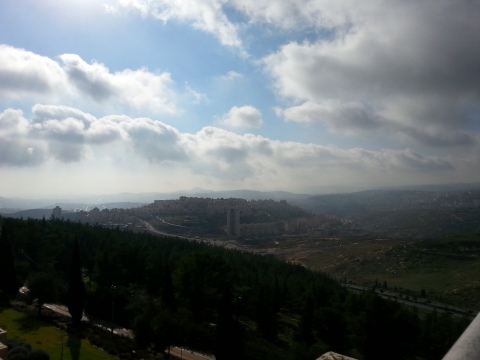
Inside the hotel lobby, there is a display of some of the many archaeological finds unearthed at Ramat Rachel, including oil-lamps from the time of Amos (as well as later finds, so one can see the developing style of oil-lamps, an artefact much loved by archaeologists, because their changing style is one of the ways by which they are able to date archaeological sites). There is also a Proto-Aeolian capital from the late First Temple Period – close enough to the time when Amos prophesied to make one wonder if, perhaps, he actually saw it and had it – or something like it – in mind when he was holding forth against the wealthy and the powerful who, from their palaces, oppressed the poor and the weak.
From Ramat Rachel, we proceeded to Beit El, on the southern border of the Kingdom of Israel. Beit El was one of two sites (the other being Dan, in the north) where Jeroboam I set up statues of a Golden Calf, after the Division of the Kingdoms (I Kings 12: 20 – 33) in order to deter the Israelites from going up to sacrifice in Jerusalem (and possibly being persuaded, as a result, to give their allegiance, once more, to the House of David). It was thus an important symbol of the rule of the Israelite kingdom.
The name of the Biblical site Beit El (Bethel) has been preserved in the name of the nearby Arab village Beitin (the replacement of the Hebrew ending -el with the Arabic -in is quite common).
Beit El was, of course, an important site from much earlier times. It was at Beit El that Jacob had his famous dream, in which he saw angels ascending and descending a ladder, and where God promised to him and his seed, “the land on which thou liest” (Genesis 28:12 – 22).
Our first stop at Beit El was the observation point atop the water tower, from where, on a clear day (which yesterday most assuredly was not!), one can supposedly see as far as Jerusalem to the south, the coastal plain to the west, and Mount Hermon in the north. Yesterday, however, was a very cloudy day, and to make matters worse, there was a very strong, cold wind blowing. The topography also made things unpleasant. Beit El is higher above sea level than Jerusalem (almost 900 ft. above sea level), and thus colder and windier and it often snows there.
It was, therefore, not possible to see very far.
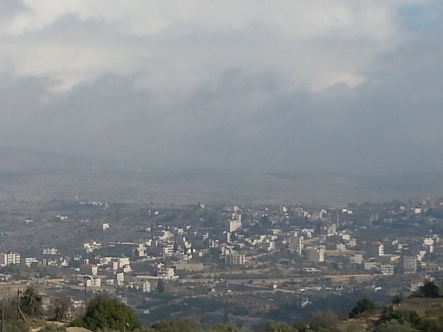
There is, however, a (modern) mosaic map of the Promised Land.
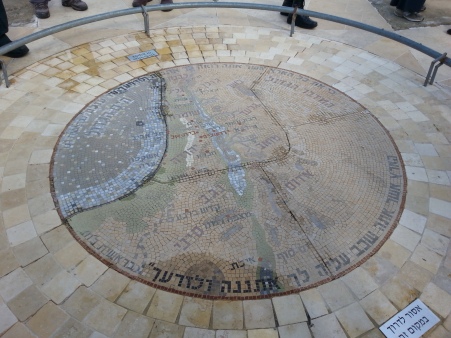
Nearby is a site known as the site of Jacob’s Dream and adjacent to it, a thousand year wormwood oak tree – maybe a descendant of the oak under which the Matriarch Rebecca’s wet-nurse Deborah was buried “below Beit El” (Genesis 35:8). At any rate, it is the oldest tree of its kind in Israel.
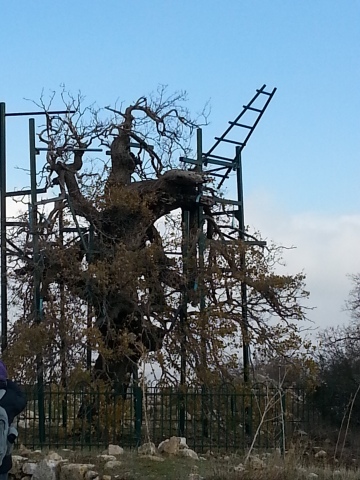
However, let us return to Amos. Amos prophesied the fall of the Israelite kingdom, not because of idolatry but, principally, because of the rampant corruption, the perversion of justice, the arrogance of its ruling class, and consequent oppression of the poor and the weak (Amos 4:1; Amos 5:7, ; Amos 5:11- 15; Amos 6:1 – 8, 12; Amos 8:4 – 6;).
Symbolic of the social injustice are the palaces of the rich and powerful:
“The Lord GOD hath sworn by Himself, saith the LORD, the God of hosts: I abhor the pride of Jacob, and hate his palaces; and I will deliver up the city with all that is therein.” (Amos 6:8).
Besides the palaces with their pillars and ornate capitals (such as the Proto-Aeolian capital hitherto described), the beds of ivory and the couches on which the aristocracy reclined while feasting and enjoying music, the wealthy citizens of Beit El built themselves winter palaces down in the Jordan Valley, in the vicinity of Jericho and the Dead Sea, to escape the cold of winter (which we ourselves experienced) – a tradition continued by later generations, including the arch-builder himself, King Herod the Great. Those unacquainted with the enormous variations in temperature to be found in what is, all told, a very small country, will be surprised when – as we did – they take the half hour drive from Beit El, up in the hills, down to Mevo’ot Yericho, down in the Jordan Valley, 150 metres below sea level. We went from 9 degrees Celsius in Beit El, to 17 degrees Celsius in Mevo’ot Yericho. So called because of its proximity to Biblical Jericho, (which Israel ceded in accordance with the Oslo Accords, and from which Jews are now banned, despite the promise in those Accords that Jews would still be permitted access to their holy sites, including the ancient synagogue of Jericho), the temperature at Mevo’ot Yericho is mild and one can easily imagine a wealthy Beit El family building a winter palace here. After reading the words of Amos, one can also imagine how they came by their wealth and understand God’s vow to “smite the winter house with the summer house” (Amos 3:15).
By now, it was almost three o’clock. At this time of year, the sun sets at about half-past four and by five-fifteen, it is dark. We still had to get to Qumran, which closes at 4 pm in winter. It meant foregoing lunch (most of us had brought sandwiches, and I, in fact, had been steadily munching mine since mid-morning!)
We reached the Qumran Park, at ten past three. The park closes at 4 pm in winter – not that this appeared to worry Arye, our guide.
Qumran is famous as the place where the Dead Sea Scrolls were discovered in 1947. It is believed to have been a settlement of the Essene sect and that these scrolls were part of their library. The scrolls contain both Biblical and non-Biblical texts. The Biblical texts include a complete copy of the Book of Isaiah, as well as parts of every single book of the Hebrew Bible, with the exception of the Book of Esther. Some of the books exist in more than one copy. The largest number of fragments, from the largest number of texts, was found in Cave 4, which is therefore the most famous of the Qumran caves – and also the most highly visible.
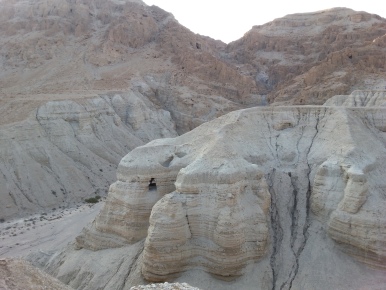
Amongst the non-Biblical documents found at Qumran, in multiple copies, was one that became known as The Damascus Document, setting forth the community’s beliefs and rules. This work was known before the discoveries at Qumran, because it was one of the fragments found in the Cairo Genizah, at the end of the 19th century, and published by Rabbi Solomon Schechter in 1910. So called because of its many references to Damascus, it is believed by many scholars that this refers, not to the actual city of Damascus, but is a symbolic reference to a distant place of exile, as referred to by Amos (Amos 5:27): “Therefore will I cause you to go into captivity beyond Damascus, saith He, whose name is the LORD God of hosts.“
Quite apart from that, it appears that Amos was “popular” among the Essenes because of his rejection and condemnation of the hedonistic and ostentatious lifestyle of the wealthy and of the aristocracy, which was so totally in opposition to their own lifestyle. Just as Amos railed against the priests of Beit El, declaring that their rituals and sacrifices were worthless, as long as they oppressed the poor and the weak, so too were the Essenes opposed to the ruling, priestly class.
The Essenes placed great emphasis on ritual purity. At Qumran, a large number of ritual purification pools (מקוואות – mikvaot) were found. Here is one:
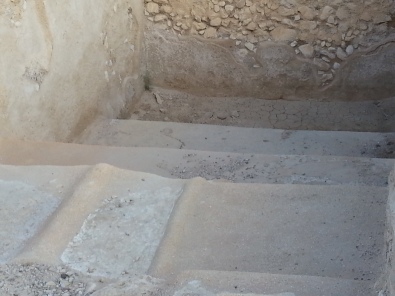
We were just exploring what some scholars believe to have been the scriptorium, where the Essene scribes supposedly performed their work of copying the holy (and secular) texts, (because tables and inkwells were discovered there), when the inexorably approaching sunset forced us to leave. We dragged our feet for as long as humanly possible 😉 but to no avail.
The orthodox men of our group (of which there are many) recited the afternoon (Mincha) prayer, and then we slowly made our way back to the bus and, as the sun went down, we turned our backs on the Dead Sea and headed back to Jerusalem to light our Hanukkah candles.
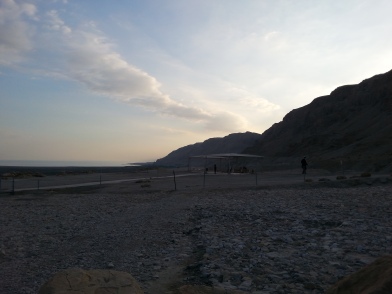
Wishing you all a Happy Hanukkah, and looking forward to seeing you again next time I post.
🙂


I enjoyed your post so very much. You live in a beautiful area with so much important history. I’m just in awe! i enjoyed clicking on the various sites you had highlighted in your post and learned so much in the process. I hope others will take the time to read those areas also. Happy Hanukkah to you.
Thank you so much! I am so glad you enjoyed it. I love it when my cat blogging friends and my human blogging friends come together, as it were.
Chag Urim Sameach! Amos is, so to speak, an old friend. I had to do set of Biblical exams, many years ago. Amos and Hosea had a three hour exam all to themselves – and no Bibles or commentaries! Nonetheless, they have stayed with me all these years. I can only hope that, in my preaching,I have done them no disservice. It was really interesting to read your post. I pray that your Bible studies will be a blessing to you, as mine were.
I am glad you found it of interest, Ian.
Do you mean there was a three hour exam devoted to Amos and Hosea or do you mean that each one had a three hour exam to himself?
I sometimes fear that we here, in Israel, pay too much attention to the last two verses of the last chapter of Amos, and not enough to what goes before…
Very interesting, Shimona. It is 40 years since my one and only spring 10 day visit to Israel. Your pictures and text bring back memories. I can smell the limestone still! The fragrance after the rain and the many scented flowers of the orange groves, jasmine, and so on.
What a fabulous old wormwood oak!
Happy Hanukkah!
Thank you, Simon. Yes, there is a special scent to the air after the rain, isn’t there?
40 years though since your last visit? Time to dust off your passport for a return visit, surely.
Happy New Year!
Well, my passport expired in 1998 and due to illness (ME/CFS Lyme). However, I have recently applied for a new one and am waiting. I may still not be well enough to travel, but you never know. Would like to. I have good periods. Spirit’s willing, flesh is weak. Happy New Year to you too!
I wish you good health.
Thank you. 🙂
I, too, wish to add my thanks for your interesting and detailed post. I’ve been reading through the Bible, slowly, atlas at my side and have learned so much. I concentrated on each place name and place description mentioned and looked them up so I’d have a better understanding of what was described. Your wee notes re: Hebrew vs. Arabic word endings was very interesting and useful.
Happy Hanukkah!
There are several atlases devoted specifically to the geography of the Bible. Which one have you been using?
Of course, when you see things actually “in 3D” as it were, it becomes even more clear – as our guides are always reminding us.
You remind me again of my time in Israel 25 years ago! It was part of my course to view these sites. In this post alone you have highlighted that the land of the land of Israel and the Jews are inextricably linked, which the shameful action of the UN Security Council tries to undermine. I loved that the Israeli representative held up the Bible as proof.
25 years is a long time! As I told Simon – time to dust off your passport for another visit 🙂
Excellent post and very informative. How fortunate you are to live in Israel and get to study and see the actual places in person. I hope you have a happy and healthy 2017!
I’m glad you enjoyed it. As I did last (academic) year, I hope to post about all the field trips in this series. So you’ll be able to take many more “virtual tours” with me.
Happy New Year to you too – and to your furbabies 🙂